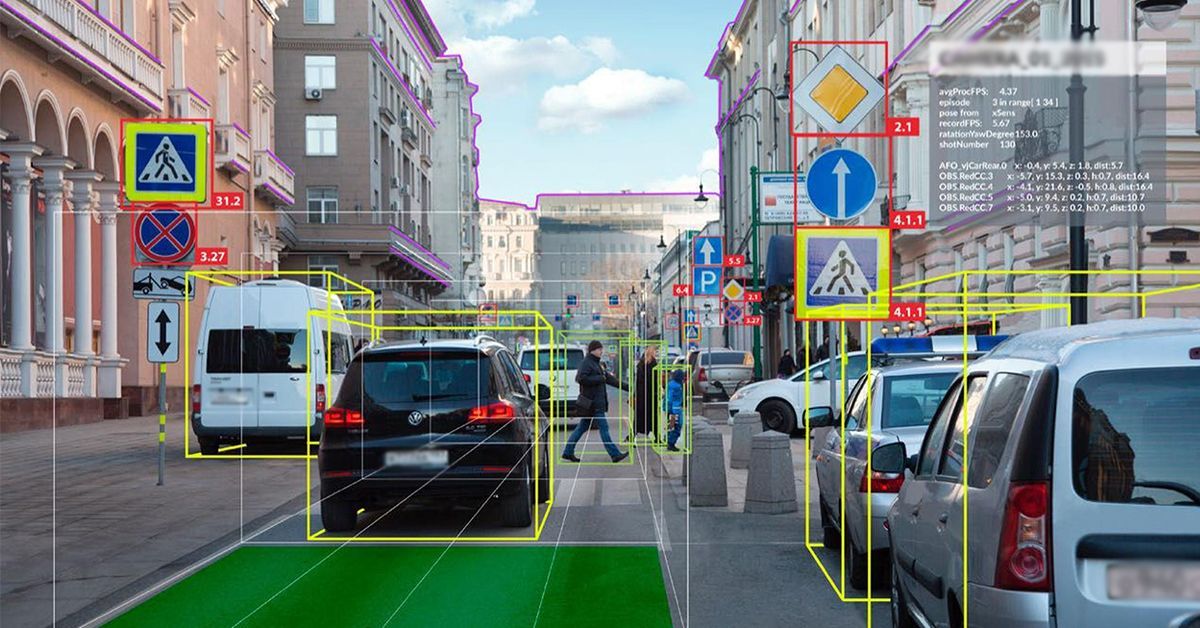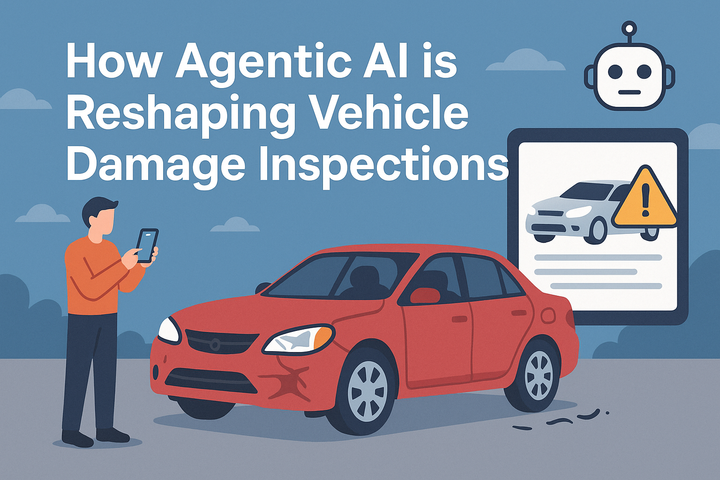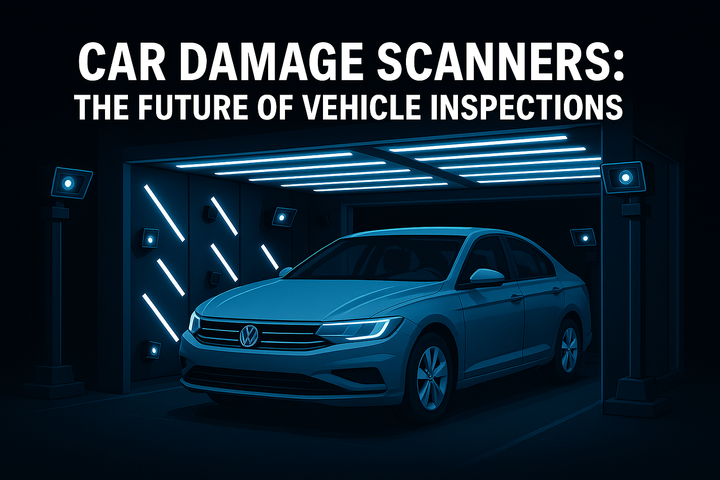How Telematics And Computer Vision Enable Automated Vehicle Inspection | Inspektlabs
The ability to detect vehicle defects is essential for border control, insurance, and security systems. With advances in computing power and graphical processing units, automated vehicle inspection solutions are becoming commercially viable.

This blog will first cover the fundamentals of computer vision and telematics. Post which, we will discuss how these technologies can be deployed to inspect cars comprehensively. We will then cover the components of car inspections and the precise role of these technologies before discussing their advantages. Lastly, we will discuss the distinction between OBD and smartphone telematics before concluding.
Introduction
Telematics and computer vision are becoming increasingly important components of the car damage inspection process. These technologies can help monitor the vehicles' health and predict problems. They also provide drivers with data on estimated repair costs. They can even determine when a car should be retired, if necessary. These technologies play a critical role in accurate car inspections.
Computer Vision
Computer vision and application-specific telematics can offer a range of benefits for car inspection, from vehicle tracking to risk assessment. They can also reduce costs associated with litigation. In addition, they can help improve driver safety. This technology can also assist car owners in lowering insurance rates.

Computer vision is already used in the automotive industry to increase product quality. Traditionally, operators have to conduct the inspection process by hand, which is subjective, time-consuming, and challenging. However, with computer vision, it has now become possible to inspect components automatically. Multiple cameras placed over a production line can detect defects in real-time. Another example is the monitoring of wheel coating intensity. The system can also identify issues in the painting process. High-resolution scans can reveal many details, such as rust and screws and other damage to undercarriage and other car parts. After analyzing the images, a confidence score can help generate more accurate vehicle identification. The application extends to car damage detection for insurance, rental, and used car industries.
Telematics
Telematics data collection includes vehicle location, speed, geographic information, incidents, fuel consumption, and other vehicle metrics. With this information, fleet managers can get an in-depth insight into their entire fleet. Most modern commercial vehicle manufacturers install telematics systems and GPS tracking devices inside their vehicles. If this is not possible, aftermarket GPS devices can be installed and powered by the vehicle's electrical system.
This technology allows vehicles to communicate with other cars, track faults, and calculate penalty points. It also enables data to feed into a business intelligence (BI) system. The technology is available in various applications, including dash cameras, dispatching, route optimization, mobile forms, and remote diagnostics.
Insurers are interested in many different factors regarding the driving habits of their insured vehicles. For example, telematics can identify the factors contributing to poor driving habits and suggest ways to improve them. Telematics also contribute to Advanced Driver Assistance Systems (ADAS) alerts and vehicle-to-vehicle communication.
With the ability to monitor driver behavior, the technology can help reduce maintenance costs and increase safety. It can also help fleet managers set up regular maintenance schedules. In addition, it can also give fleet managers an insight into the driving habits of their drivers, enabling them to implement individual coaching sessions and training programs for drivers.
Many automotive players have already started investing in modern telematics systems to give them a competitive edge. Application-specific telematics and computer imaging can provide fleet managers with a multitude of information on the status of their vehicles. It can also reduce collisions and improve fuel efficiency. The automotive industry has widely embraced automated mobile vehicle inspection technology combining telematics and computer vision. The system allows drivers to upload images and collect data on vehicle health and potential issues. The data is then analyzed and backed up in a central database. The system is also compatible with telematics devices and provides fleet managers with near real-time data.
Telematics and Computer Vision in Car Inspections
There are a few components of car inspection: external damages, internal damages, text reading, engine performance, and driver behavior. Neither telematics nor computer vision can independently capture or inspect all these components. However, these technologies are flexible and can detect multiple types of damage. Furthermore, these technologies are complementary to each other. So, when we deploy them together as a unified vehicle inspection system, they asses the car entirely and comprehensively. Let us briefly consider each of these components.

External Damages
Detecting external damages is exclusively the domain of computer vision. Most external damages are detectable through computer vision. The most recent computer vision methodologies can locate external damages on a car's body and assist businesses in quantifying them without much human labor. Additionally, this technology enables automobile insurers to handle claims more quickly and automatically analyze damage through photos and videos.
Internal Damages
Detecting internal damages is a more complex task. Both telematics and computer vision assist in analyzing internal damages. Telematics can provide information regarding the g-force, acceleration, harsh braking and driving, and similar factors illuminating the car's status upon impact. This data can help determine the extent and severity of the impact. The computer vision AI calculates and identifies which internal components are likely to sustain damage based on external damages. It does so by correlating which internal parts correspond to which external parts of the car.
Text Reading
Text reading is the exclusive domain of computer vision. For example, Inspektlabs's AI can auto-read VIN, odometer, license plate, or any other text captured in the photos or videos of the vehicle. This information is indispensable because it matches the car's visuals to the relevant identifying information. Text reading helps prevent fraud that arises due to misrepresenting a vehicle.
Engine Performance
Telematics can gather data on engine load and engine temperature. It can further help run engine diagnostics by analyzing the powertrain, oxygen sensors, intake valves, battery voltage, and coolant temperature.
Driver Behavior
The telematics associated with driver behavior can help monitor and track distances traveled, fuel waste and related costs, idle time, and driving habits. It can also log instances of harsh driving, such as hard cornering or braking. In addition, it can also give fleet managers an insight into the driving habits of their drivers, enabling them to implement individual coaching sessions and training programs for drivers.

The following table summarizes the aspects of car inspection that each technology covers.
|
Car
Inspection Components |
Telematics |
Computer
Vision |
|
External
Damages |
- |
✓ |
|
Internal
Damages |
Partial,
G Force |
Partial,
Via External Damages |
|
Text
Reading (Odometer, VIN) |
- |
✓ |
|
Engine
Performance |
✓ |
- |
|
Driver
Behavior |
✓ |
Partial |
What Are The Advantages Of Using Telematics And Computer Vision Together?
Telematics and computer vision can identify problems with panel alignment, fit, and finish, as well as scratches, dents, and scrapes. The information can then incorporate into typical business and dealer systems. In addition, the system can produce a complete vehicle report within a few seconds. However, there are some exceptions, such as air conditioning and repainting inspection, that these two technologies cannot cover. While solutions to assess these components do exist, they are not yet incorporated into the broader system. A separate device can evaluate the depth of paint, for example. Nonetheless, the combination of these solutions offers many advantages over manual inspections.
These technologies can flag defects with high accuracy without requiring manual checks. The technology uses machine learning models to detect defects. This technology can also personalize algorithms, allowing manufacturers to tailor them to their vehicles. It can speed up the quality control process by identifying faults before they become visible to humans.
These technologies have a wide range of applications in the car inspection industry. For example, it can help check the assembly of car components to ensure that they meet safety standards. These systems capture ultra-high-resolution images and provide real-time insights about the condition of a vehicle. The detailed pictures and videos comprehensively view any damage or specification issue.
Many advantages predominantly benefit automotive insurance companies. Claim estimation, for example, has been elevated to a different level altogether using these technologies. For accuracy, the most recent accident and impacts must be determined and analyzed during an insurance claim process. Telematics and computer vision can help determine which side of the car impacted and which parts of the vehicle were damaged due to the most recent incident. The system automatically registers these damages during claim estimation to produce reliable and consistent results. There are two modes of facilitating these car inspections, viz. OBDs and smartphones.
OBD vs. Smartphones Telematics
OBD (On-Board Diagnostics) devices are frequently installed on trucks, fleet vehicles, logistics and transportation automobiles, and other uses, including market research and automobiles owned by drivers with insurance. Before smartphones, OBDs were the only reliable method of gathering information. But with the rise of smartphones, OBDs are not the most effective means to collect data on driver behavior and vehicle tracking.

OBDs are not sophisticated technological devices. Since entering the market, they have not changed much, keeping features and usefulness constrained, irrespective of the manufacturer. The hardware and software are not updated as often as on smartphones. That usually necessitates purchasing a new OBD gadget to keep up. In contrast, smartphone users often replace their gadgets every one to two years, automatically leading to new and improved sensors.
Smartphones are significantly more capable of collecting, storing, processing, and obtaining accurate mobile telematics data than OBDs. Smartphones are widely available and reasonably priced; even the most basic models include several sensors. Consumer habits lead to the release of new devices, and frequent software updates ensure that the rate of innovation moves quickly.
Conclusion
The ability to detect vehicle defects is essential for border control, insurance, and security systems. With advances in computing power and graphical processing units, automated vehicle inspection solutions are becoming commercially viable. These systems can detect defects on the first pass when paired with powerful cloud computing platforms. The algorithms will improve accuracy as more telematics, and computer vision data is collected.



